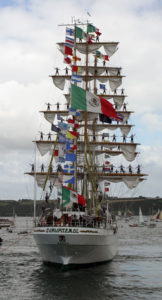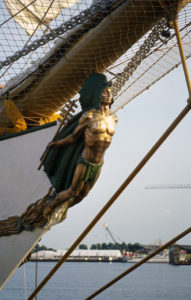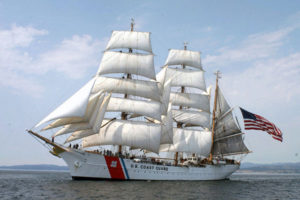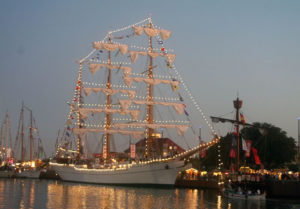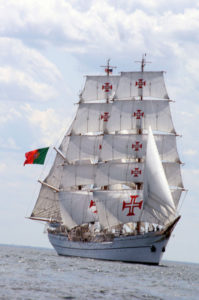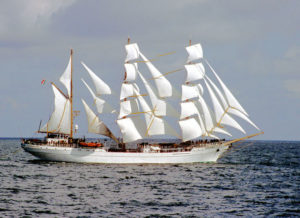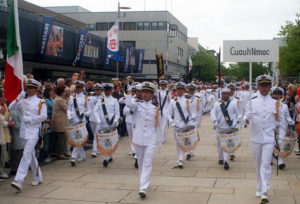| 1 | Rio de Janeiro Brazil | February 2-7 |
| 2 | Mar de Plata Argentina | February 21-26 |
| 3 | Montevideo Uruguay | February 28-March2 |
| 4 | Buenos Aires Argentina | March 4-9 |
| 5 | Isla de los Estados Argentina | March 18 |
| 6 | Ushuaia Argentina | March 19/20-23 |
| 7 | Cabo de Hornos Chile | March 23/24 |
| 8 | Punta Arenas Chile | March 26-29 |
| 9 | Talcahuano Chile | April 6-10 |
| 10 | Isla Robinson Crusoe Chile | April 12 |
| 11 | Valpariso Chile | April 14-19 |
| 12 | Callao Peru | April 27-May 1 |
| 13 | Guayaquil Ecuador | May 6-11 |
| 14 | Cartagena de Indias Colombia | May 19-23 |
| 15 | La Guayra Venezuela | May 29-June 3 |
| 16 | Veracruz Mexico | June 18-23 |
What could be more beautiful than tall ships with sails billowing in the wind as they surge across the ocean? These wonderful sailing ships carry a sense of history and adventure. In June of 2010, many elegant vessels come together in a regatta that will culminate in the port of Veracruz, Mexico from June 23rd through the 28th — a great opportunity to see them in action. What’s behind it?
Vela Sud America is an enterprising, bicentennial commemoration of the creation of the independent South and Latin American navies in the early 18th century. To celebrate, the fleet is circumnavigating South America from the Atlantic to the Pacific to finish in the Gulf of Mexico.
The Ships
The fleet will be composed of 12 Class A tall ships representing 12 separate nations. The Juan Sebastian de Elcano from Spain, the Sagres II from Portugal, the Europa from the Netherlands, Cisne Branco from Brazil, Capitan Miranda from Uruguay, Libertad from Argentina, Esmeralda from Chile, Guayas from Ecuador, Gloria from Colombia, Simon Bolivar from Venezuela and, Cuauhtemoc from Mexico will be joined by the USCGA Eagle for the last leg of the regatta. All but Europa are sail-training vessels, dedicated to preparing young midshipmen to be officers in their respective navies and coastal services.
Each of the tall ships has a unique history and national personality, and each deserves some attention in the form of a photograph and caption to describe it. They have unique lengths and rigs, picturesque figureheads, and colorful crews. The ships and their crews have sailed all the seven seas, and have acted as good-will ambassadors for their countries in international festivals and regattas, and state visits.
Juan Sebastian de Elcano
Juan Sebastian de Elcano is named in honor of the sole captain of Magellan’s famed fleet to survive the passage of circumnavigating the globe in the 16th century. The historical Juan Sebastian de Elcano received the title “primus circumdedisti me” from King Carlos V upon his triumphant return to Spain in 1522.
Sagres II
With its celebratory figurehead of Prince Henry the navigator, Sagres II takes her name from the Portuguese prince Sagres. In the 15th century, he founded the navigational school that send forth the great explorers of the Atlantic, Pacific, and Indian oceans.
Cuauhtemoc
Mexico’s Cuauhtemoc carries the figure of the last Aztec emperor on its bow.
The other tall ships each have a national contribution to the history of South America.
Venezuela’s barque Simon Bolivar honors the founder and liberator of the independent South American nations and navies.
Cisne Branco
The wonderfully fresh clipper ship, Cisne Branco or “White Swan” from Brazil was built in 1999-2000. This tall ship embodies the speed, elegance, and mission of the continent’s largest country.
Two southern entries from Uruguay and Argentina represent innovation, and adaptability.
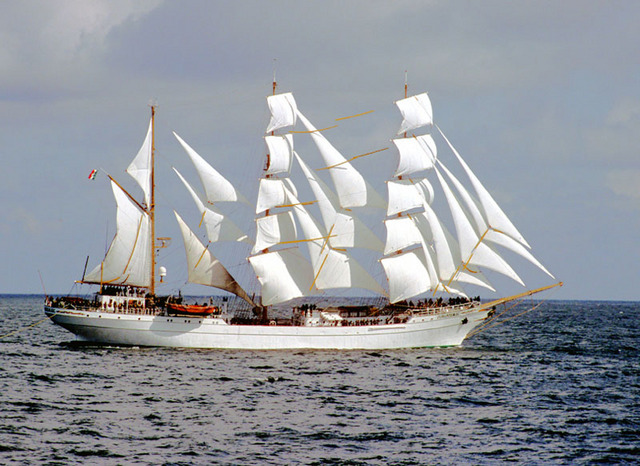
Libertad
Argentina’s Libertad was the first sail-training ship in the South American fleet. Built in 1956 of classic riveted steel-plates, this traditional full-rigged ship incorporated the traditions and the disciplines of the European “sailing school ships.”
| SHIP | COUNTRY | RIG | LENGTH | YEAR BUILT |
| Cuauhtemoc | Mexico | Barque | 290 ft | 1982 |
| Juan Sebastian de Elcano | Spain | Topsail schooner | 370 ft | 1927 |
| Sagres II | Portugal | Barque | 293 ft | 1937 |
| Simon Bolivar | Venezuela | Barque | 270 ft | 1980 |
| Cisne Branco | Brazil | Ship | 256 ft | 1999-2000 |
| Libertad | Argentina | Ship | 356 ft | 1956 |
| Capitan Miranda | Uruguay | Staysail schooner | 205 ft | 1930 |
| Esmeralda | Chile | Barquentine | 371 ft | 1952-54 |
| Guayas | Ecuador | Barque | 257 ft | 1976 |
| Gloria | Colombia | Barque | 249 ft | 1968 |
| Europa | The Netherlands | Barque | 185 ft | 1911-1994 |
| Eagle | USA | Barque | 295 ft | 1936 |
Capitan Miranda
On the other hand, Capitan Miranda began her life on the water with the mission of charting and defining the coastline and waterways of Uruguay. After she completed that mission in 1950, the Uruguayan Navy then converted the oceanographic motor-trawler to an elegant three-masted stay-sail schooner.
Europa
Europa is the only non-military tall ship in the fleet. She was originally a “light-ship” that signaled a particularly critical navigational position on the ocean, in her case, the mouth of the Elbe river leading to the port of Hamburg. Retired with technological advances in GPS systems and radar, the Europa was restructured. She had higher masts added and ballast removed to emerge from the conversion as a three-masted barque. Europa has been a successful sail-training cruise ship with a regular schedule of cruises around Cape Horn to the Galapagos Islands and the continent of Antarctica.
Gloria and Guayas
The two remaining “sister-barques” are the Gloria from Colombia and the Guayas from Ecuador.
Both tall ships will host the Vela Sud America fleet in their homeports of Cartagena and Guayaquil. Built from the essentially the same plans, the two have the extended bridges, which overlap the main deck from port to starboard sides.
Eagle
The Eagle, which became the property of the U.S. Coast Guard Academy, is interestingly a “sister-ship” to the Portuguese Sagres II. Both were built in Germany in the 1930s.
Cuauhtemoc
Finally, Mexico’s Cuauhtemoc will host the regatta in Veracruz and welcome the U.S. Coast Guard Eagle to the festivities. Interestingly, the Eagle has hosted all of the vessels in the OpSail events in New York in 1976, 1984, 1992, and 2000.
By all means, plan to be in Veracruz from June 23rd through the 28th to enjoy this event and see these extraordinary ships.

